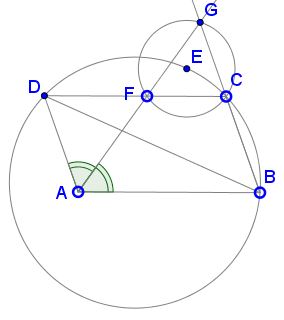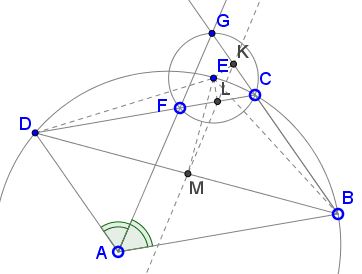Angle Bisector in Parallelogram
What Is It About?
A Mathematical Droodle
|Activities| |Contact| |Front page| |Contents| |Geometry| |Eye opener|
Copyright © 1996-2018 Alexander Bogomolny
Angle Bisector in Parallelogram
The applet illustrates Problem 2 from IMO 2007:
Consider five points $A,\,$ $B,\,$ $C,\,$ $D\,$ and $E\,$ such that $ABCD\,$ is a parallelogram and $BCED\,$ is a cyclic quadrilateral.

Let $\ell\,$ be a line passing through $A.\,$ Suppose that $\ell\,$ intersects the interior of the segment $DC\,$ at $F\,$ and intersects line $BC\,$ at $G.\,$ Suppose also that $EF = EG = EC.\,$ Prove that $\ell\,$ is the bisector of angle $DAB.$
Solution 1
The solution is an adaptation of that by Anton Batominovski (a simpler variant appears elsewhere.)
The condition $EF = EG = EC\,$ is equivalent to $E\,$ being the circumcenter of $\Delta CFG.\,$ Thus we shall prove a stronger result:
Consider five points $A,\,$ $B,\,$ $C,\,$ $D\,$ and $E\,$ such that $ABCD\,$ is a parallelogram and $BCED\,$ is a cyclic quadrilateral. Let $\ell\,$ be a line passing through $A.\,$ Suppose that $\ell\,$ intersects the interior of the segment $DC\,$ at $F\,$ and intersects line $BC\,$ at $G.\,$ The circumcenter $E\,$ of $\Delta CFG\,$ lies on the circumcircle of $\Delta BCD\,$ if and only if $\ell\,$ bisects $\angle DAB.$
Assume first that $\ell\,$ is the bisector of $\angle BAD.\,$ This makes $\Delta ABG\,$ isosceles so that $BG = AB.\,$ Since ABCD is a parallelogram we also have $CD = AB\,$ implying $BG = CD.$

$\Delta FCG\,$ is also isosceles (and similar to $\Delta ABG.)\,$ In particular, $EC\,$ being its apex altitude and angle bisector,
$\angle ECF = \angle ECG.$
But, since $E\,$ is the circumcenter of $\Delta CFG,\,$ $\Delta CEG\,$ is isosceles, $\angle CGE = \angle ECG\,$ making $\angle ECF = \angle CGE.\,$ The bottom line is in triangles $CDE\,$ and $GBE,\,$ $EC = EG,\,$ $CD = BG,\,$ and $\angle CGE = \angle ECG,\,$ from which $\Delta CDE = \Delta GBE.\,$ The two triangles are obtained from each other by a rotation around $E.\,$ This implies the angles between corresponding sides are equal, namely, $\angle BCD = \angle BED\,$ so that $\angle BED\,$ is inscribed into the circumcircle of $BCD.$
Now let's prove the converse. Assume $E\,$ lies on the circumcircle of $\Delta BCD.\,$ By the Simson-Wallace Theorem theorem, the feet of the perpendiculars $EK,\,$ $EL,\,$ $EM\,$ from $E\,$ to the sides $BC,\,$ $CD,\,$ $BD\,$ are collinear on the Simson line, where $K\,$ is the midpoint of $CG,\,$ while $L\,$ is the midpoint of $CF.\,$ The homothety with center $C\,$ and coefficient $2\,$ maps $K\,$ onto $G,\,$ $L\,$ onto $F,\,$ the line $KL\,$ onto $\ell\,$, and the diagonal $BD\,$ onto a parallel line through $A.\,$ $M\,$ being on the two lines is mapped to the intersection of their images, which is $A.\,$ This makes $M\,$ the midpoint of the diagonal $AC\,$ and, as a consequence, also the midpoint of the diagonal $BD.\,$ $\Delta BED\,$ is then isosceles, with $BE = DE\,$ and $\angle DBE = \angle BDE\,$ and $EM \perp BD.$
On the other hand, $\angle DBE = \angle DCE\,$ (as inscribed angles subtended by the same chord). Also, since $BCDE\,$ is cyclic, $\angle BDE\,$ is supplementary to $\angle BCE\,$ as is $\angle GCE\,$ so that $\angle BDE = \angle GCE\,$ leading finally to
$\angle DCE = \angle GCE$
making $CE\,$ an angle bisector in $\Delta CFG.\,$ But since $E\,$ is the circumcenter of $\Delta CFG\,$ it also becomes the altitude and the median from $C\,$ which means that $\Delta CFG\,$ is isosceles as are triangles $ADF\,$ and $ABG.\,$ All three are similar and we finally get $\angle DAG = \angle BAG.$
Solution 2
This solution is by Amit Itagi.
Let $X$, $Y$, $Z$ form a right handed coordinate system such that the positive $X$ direction point from $C$ to $G$ and the positive $Z$ points out of the plane of the screen. Let $CG=p$, $CB=q$, $CD=s$, and $\angle GCF=\phi$.
$\begin{align} \vec{CG}&= p\hat{x} \\ \vec{CB}&= -q\hat{x} \\ \vec{CD}&= s\cos\phi\hat{x}+s\sin\phi\hat{y} \\ \vec{CA}&= \vec{CB}+\vec{CD}=(s\cos\phi-q)\hat{x}+s\sin\phi\hat{y} \end{align}$
For some $k$,
$\vec{CF}=k\vec{CA}+(1-k)\vec{CG} =[k(s\cos\phi-q)+p(1-k)]\hat{x}+ks\sin\phi\hat{y}.$
Due to collinearity with $\vec{CD}$, the components need to be in the same proportion. Thus,
$\begin{align} &[k(s\cos\phi-q)+p(1-k)]\sin\phi=ks\sin\phi\cos\phi \\ &\Rightarrow k=\frac{p}{p+q} \\ &\Rightarrow \vec{CF}=\frac{ps}{p+q}(\cos\phi\hat{x}+\sin\phi\hat{y}). \end{align}$
Point $E$ lies on the perpendicular bisector of $CG$. Thus, for some $m$,
$\vec{CE}=\frac{p}{2}\hat{x}+m\hat{y}.$
$|\vec{CE}|=|\vec{EF}|=|\vec{CF}-\vec{CE}|$ implies
$\begin{align}&\frac{p^2}{4}+m^2=\left(\frac{ps}{p+q}\cos\phi-\frac{p}{2}\right)^2+\left(\frac{ps}{p+q}\sin\phi-m\right)^2 \\ &\Rightarrow m=-\frac{p[(p+q)\cos\phi-s]}{2(p+q)\sin\phi} \\ &\Rightarrow \vec{CE}=\frac{p}{2}\hat{x}-\frac{p[(p+q)\cos\phi-s]}{2(p+q)\sin\phi}\hat{y}. \end{align}$
Let $O$ be the center of the circle($BCD$). Thus, for some $t$,
$\vec{CO}=-\frac{q}{2}\hat{x}+t\hat{y}.$
$|\vec{CO}|=|\vec{DO}|=|\vec{CO}-\vec{CD}|$ implies
$\begin{align} &\frac{q^2}{4}+t^2=\left(-\frac{q}{2}-s\cos\phi\right)^2+\left(t-s\sin\phi\right)^2 \\ &\Rightarrow t=\frac{q\cos\phi+s}{2\sin\phi} \\ &\Rightarrow \vec{CO}=-\frac{q}{2}\hat{x}+\frac{q\cos\phi+s}{2\sin\phi}\hat{y}. \end{align}$
Finally, $|\vec{CO}|=|\vec{EO}|=|\vec{CO}-\vec{CE}|:$
$\begin{align} &\frac{q^2}{4}+\frac{(q\cos\phi+s)^2}{4\sin^2\phi}= \\ &\qquad\qquad\left(\frac{q}{2}+\frac{p}{2}\right)^2+\left(\frac{q\cos\phi+s}{2\sin\phi}+ \frac{p[(p+q)\cos\phi-s]}{2(p+q)\sin\phi}\right)^2 \\& \Rightarrow \frac{pq}{2}+\frac{p^2}{4}+\left(\frac{p[(p+q)\cos\phi-s]}{2(p+q)\sin\phi}\right) \\ &\qquad\qquad\times\left(\frac{q\cos\phi+s}{\sin\phi}+\frac{p[(p+q)\cos\phi-s]}{2(p+q)\sin\phi}\right)=0 \\ & \Rightarrow 2pq(p+q)^2\sin^2\phi+p^2(p+q)^2\sin^2\phi+ \\ &\qquad\qquad p[(p+q)\cos\phi-s]\{2(p+q)(q\cos\phi+s)+p[(p+q)\cos\phi-s]\}\\ &=0 \\ &\Rightarrow p(p+2q)[(p+q)^2-s^2]=0 \\ & \Rightarrow (p+q)^2=s^2~(QED) \end{align}$
Note: $\angle GFC = \angle GAB$ and $\angle DAF = \angle FGC$. Thus, proving that line $l$ is the angle bisector of $\angle DAB$ is equivalent to proving that $|\vec{CG}|=|\vec{CF}|$ or $(p+q)^2=s^2$.
|Activities| |Contact| |Front page| |Contents| |Geometry| |Eye opener|
Copyright © 1996-2018 Alexander Bogomolny
73581157
